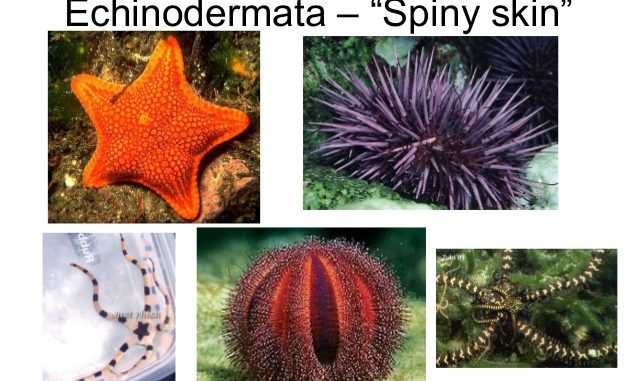
- Habitat:
- They are commonly called spiny skinned animals.
- All are marine, generally live in sea bottom and are slowly moving animals.
- Some animals are pelagic (free swimming in open water) and few are sessile (attached to the substratum).
- Body structure:
- They are variably shaped; star shaped, spherical, cylindrical etc.
- Head is absent and the body bears spines and
- The adults are radially symmetrical (pentamerous radial symmetry) and the larvae are bilaterally symmetrical.
- The body is triploblastic with outer ciliated epidermis, middle dermis and inner peritoneum.
- Dermis has a calcareous plate and muscles are smooth.
- Body cavity is in the form of enterocoelous coelom that is surrounded by ciliated peritoneum.
- Water vascular system:
- Body is provided with water vascular system or ambulacral system.
- The inlet canal called madreporite is present as a perforated plate.
- Tube-feet of this system help in locomotion, respiration and food capturing.
- Tube feet consist of ampulla, podium and sucker.
- Digestive tract is complete but incomplete in some forms like brittle star.
- Circulatory system:
- It is of open type and consists of five radiating vessels.
- Heart is absent and instead of blood vascular system, there is presence of haemal and perihaemal system.
- Blood doesn’t contain any respiratory pigment.
- Respiratory system:
- Dermal branchiae or papulae present in star fish, peristominal gills in sea urchin and genital bursae in the brittle star help in respiration.
- Cloacal respiratory trees are found in Holothurians in which the lower branch is called cuverian organs (protective in function).
- Excretory system:
- Generally, it is absent and they are ammonotelic.
- Excretion is by wandering amoebocytes.
- Nervous system:
- Brain is absent but the nerve ring and radial nerve cords are present.
- Autotomy and regeneration are well marked.
- Reproduction:
- It takes place sexually.
- The sexes are separate and in except few forms fertilization is external.
- Few are viviparous and the development is indirect.
- Larva is ciliated, bilaterally symmetrical and after metamorphosis, adult becomes radially symmetrical.
- Bipinnaria and Brachiolaria are the larval forms in star fish, Ophioputeus in brittle star, Pleteus in sea urchin, Auricularia in sea cucumber and Doliolaria in feather star.
Classification:
- Phylum Echinodermata is divided into two sub-phyla; Pelmatozoa and Eleutherozoa.
- Pelmatozoa has only one living class Crinoidea.
- Eleutherozoa has four living classes; Holothroidea, Echinoidea, Asteroidea and
Class: Crinoidea
- Mouth is usually central and anus is eccentric. Both are present on the oral surface.
- Water vascular system and madreporite are absent.
- Spines and pedicellariae are present.
- They are commonly called sea lilies or feather stars.
- Development is indirect and the larva is Doliolaria.
- e.g. Antedon, Metacrinus
Class: Holothuroidea
- Mouth is surrounded by a set of tentacles attached to the water vascular system.
- Alimentary canal is long and coiled and cloaca is supplied with respiratory trees for respiration.
- They are commonly called sea cucumbers.
- Development is indirect with Auricularia larva.
- Autotomy is by evisceration (removal or viscera).
- e.g. Holothuria, Thyone
Class: Echinoidea
- Mouth is centrally located on the oral surface while anus is on the aboral surface.
- They have jaw suspension called Aristotle’s Lantern (i.e. chewing apparatus).
- They are commonly called sea urchins and sand dollars.
- Development is indirect with Echinopliteus larva.
- e.g. Echinus, Clypeaster
Class: Asteroidea
- They have pentamerous radial symmetry.
- Mouth is pentagonal, centrally placed on the oral surface while anus is on the aboral surface.
- Madreporite is on the dorsal side.
- Endoskeleton is flexible and is made up of separate ossicles.
- They are commonly called star fish or sea stars.
- Development is indirect with Bipinnaria or Brachiolaria larvae.
- e.g Solaster, Asterias (star fish)
Class: Ophiuroidea
- The oral and aboral surfaces are distinct.
- Ambulacral groove, anus and intestine are absent.
- Autotomy of arms are commonly observed in brittle stars.
- Development is indirect and the larva is Pluteus larva.
- e.g. Ophiothrix, Ophioderma